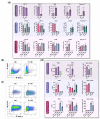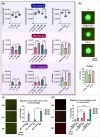Establishment and Characterization of Free-Floating 3D Macrophage Programming Model in the Presence of Cancer Cell Spheroids
- PMID: 37445941
- PMCID: PMC10341749
- DOI: 10.3390/ijms241310763
Establishment and Characterization of Free-Floating 3D Macrophage Programming Model in the Presence of Cancer Cell Spheroids
Abstract
Reprogramming of tumor-associated macrophages (TAMs) is a promising strategy for cancer immunotherapy. Several studies have shown that cancer cells induce/support the formation of immunosuppressive TAMs phenotypes. However, the specific factors that orchestrate this immunosuppressive process are unknown or poorly studied. In vivo studies are expensive, complex, and ethically constrained. Therefore, 3D cell interaction models could become a unique framework for the identification of important TAMs programming factors. In this study, we have established and characterized a new in vitro 3D model for macrophage programming in the presence of cancer cell spheroids. First, it was demonstrated that the profile of cytokines, chemokines, and surface markers of 3D-cultured macrophages did not differ conceptually from monolayer-cultured M1 and M2-programmed macrophages. Second, the possibility of reprogramming macrophages in 3D conditions was investigated. In total, the dynamic changes in 6 surface markers, 11 cytokines, and 22 chemokines were analyzed upon macrophage programming (M1 and M2) and reprogramming (M1→M2 and M2→M1). According to the findings, the reprogramming resulted in a mixed macrophage phenotype that expressed both immunosuppressive and anti-cancer immunostimulatory features. Third, cancer cell spheroids were shown to stimulate the production of immunosuppressive M2 markers as well as pro-tumor cytokines and chemokines. In summary, the newly developed 3D model of cancer cell spheroid/macrophage co-culture under free-floating conditions can be used for studies on macrophage plasticity and for the development of targeted cancer immunotherapy.
Keywords: 3D cell culture models; cancer cell spheroids; chemokines; cytokines; macrophage plasticity; macrophage polarization; macrophage reprogramming; tumor-associated macrophages.
Conflict of interest statement
The authors declare no conflict of interest.
Figures









Similar articles
-
Macrophage infiltration in 3D cancer spheroids to recapitulate the TME and unveil interactions within cancer cells and macrophages to modulate chemotherapeutic drug efficacy.BMC Cancer. 2023 Dec 7;23(1):1201. doi: 10.1186/s12885-023-11674-9. BMC Cancer. 2023. PMID: 38062442 Free PMC article.
-
Pancreatic cancer cell/fibroblast co-culture induces M2 like macrophages that influence therapeutic response in a 3D model.PLoS One. 2017 Jul 27;12(7):e0182039. doi: 10.1371/journal.pone.0182039. eCollection 2017. PLoS One. 2017. PMID: 28750018 Free PMC article.
-
Mimicking the tumor microenvironment to regulate macrophage phenotype and assessing chemotherapeutic efficacy in embedded cancer cell/macrophage spheroid models.Acta Biomater. 2017 Mar 1;50:271-279. doi: 10.1016/j.actbio.2016.12.037. Epub 2016 Dec 21. Acta Biomater. 2017. PMID: 28011141 Free PMC article.
-
The Role of M1/M2 Macrophage Polarization in Rheumatoid Arthritis Synovitis.Front Immunol. 2022 May 19;13:867260. doi: 10.3389/fimmu.2022.867260. eCollection 2022. Front Immunol. 2022. PMID: 35663975 Free PMC article. Review.
-
The role of metabolic reprogramming of tumor-associated macrophages in shaping the immunosuppressive tumor microenvironment.Biomed Pharmacother. 2023 May;161:114504. doi: 10.1016/j.biopha.2023.114504. Epub 2023 Mar 14. Biomed Pharmacother. 2023. PMID: 37002579 Review.
Cited by
-
Styrylpyridinium Derivatives for Fluorescent Cell Imaging.Pharmaceuticals (Basel). 2023 Sep 4;16(9):1245. doi: 10.3390/ph16091245. Pharmaceuticals (Basel). 2023. PMID: 37765053 Free PMC article.
-
Macrophage colony-stimulating factor and its role in the tumor microenvironment: novel therapeutic avenues and mechanistic insights.Front Oncol. 2024 Apr 4;14:1358750. doi: 10.3389/fonc.2024.1358750. eCollection 2024. Front Oncol. 2024. PMID: 38646440 Free PMC article. Review.
-
Macrophage Transcriptomic Alterations Driven by Alphavirus-Based Cancer Immunotherapy Vectors.J Immunol Res. 2025 Jun 13;2025:6573891. doi: 10.1155/jimr/6573891. eCollection 2025. J Immunol Res. 2025. PMID: 40547518 Free PMC article.
-
Macrophage Polarization: Learning to Manage It 3.0.Int J Mol Sci. 2025 Jan 1;26(1):311. doi: 10.3390/ijms26010311. Int J Mol Sci. 2025. PMID: 39796166 Free PMC article.
References
MeSH terms
Substances
Grants and funding
LinkOut - more resources
Full Text Sources
Medical

